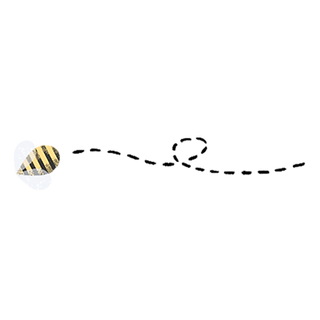Bees Buzzing with B
Emergent Literacy Design
Rationale: This lesson will help children identify /b/, the phoneme represented by B. Students will learn to recognize /b/ in spoken words by learning a meaningful representation (making the “b” sound that is used in words like bug and bat), and the letter symbol B. Students will practice finding /b/ in words and then apply phoneme awareness with /b/ in phonetic cue reading by distinguishing rhyming words from beginning letters.
Materials:
-
Pencils and primary paper
-
Tongue twister chart
-
Worksheet handouts on the letter B
-
Markers
-
Crayons
-
Computer to watch Letter B video on YouTube
-
Word card with words: BEE, LAD, BOAT, FLIP, BELL, BIRD, DECK, RED
Procedures:
-
Teacher: Today we will be learning about the letter We are going to learn that and both make the same sound when we say them! Like when you hear bees go “b-b-b-b-uzzz” whenever they are around you. We are going to learn how our mouths move when as we say each letter sounds when we say words. Today we are going to spot our mouths move when we say makes the noise , like when we say bee. Let’s practice saying “black bees buzz” together!
-
Ask the students if any of them can write an uppercase or lowercase on the board. If none of them know how to write it correctly, then the teacher can demonstrate how they are written on the board.
-
Then ask the students if they can name somethings that start with the letter . they can be names, animals, food, or anything that comes to their mind.
-
Say: Let’s pretend to make a buzzing sound. [b-b-b-uzzzz] Notice where our mouths are when we make that sound? Our mouths are pressed together when we say the letter b, then they open their mouth and a puff of air comes out.
-
Say: Let’s watch a quick video that shows us many different words that start with the letter and make the sound!
-
Let’s try a tongue tickler! [chart is on the board] Ben has a butterfly, a small blue one. The bird has been going through some changes in the past couple of days. Now Ben’s butterfly is a beautiful color of blue and black! Here’s our tickler, “Ben’s beautiful butterfly is black and blue.” Now let’s all say it three times together. [sentence is repeated 3x by students and teacher] now this time when we say it, we are going to stretch out the at the beginning of all the words. “Bbbben’s bbbbeautiful bbbbutterfly is bbbblack and bbbblue.” And for this last try, we are going to break it off the word, “/b/ en’s /b/ eautiful /b/ utterfly is /b/ lack and /b/ lue.”
-
We are all going to read a book together now called Big Red Barn. This book is about a big red barn that is in the middle of great green field. There are pigs, horses, sheep, goats, and lots of many other animals that roam about the farm. Let’s start reading so we can find out what all of these different animals do throughout the day and if they all get along with each other!
-
Students will get out their pencils and primary paper to write the uppercase and lowercase b on their own. “To make the uppercase B, we will start at the top and draw a line straight done. The you will take your pencil back to the top and draw a curve line to the middle line. Then you will draw another curve line from the middle line to the bottom, and now you have completed a capital B! to draw a lowercase b, you will draw a straight line form the top to the bottom just like we did. Then we will start from the middle line and make a curve line from the bottom, and now we know how to draw a lowercase b!”
-
Call on students to answer and tell how they knew: “Do you hear in or ? or ? or ? or ? or ?” Then continue to go on and say “Let’s see if you can spot your mouth move in some of these words. Flap your hands like a bee would flap their wings if you hear the .
-
Next, the teacher can play a little game with the students that is interactive and incorporates the lesson. It’s an activity called ‘Let’s Pretend’ where we would go around the room and the students would have to say a word that started with a and then they would have to act out that word. Some examples could be bear, baby, baseball player, bird, ballerina, etc.
-
Show BEE and model how to decide if it is bee or me: “The B tells us to move our arms like a bumble bee when he buzzes, so this word is bbbb-ee. Now let’s all try some together. LAD: bad or lad? BOAT: boat or float? FLIP: flip or bit? BELL: bell or tell? BIRD: bird or cat? DECK: deck or bread? RED: blue or red?
-
For assessment, the teacher will then pass out the All About the Letter B worksheet to the students. Students can trace the capital B and lowercase that is demonstrated on the worksheet, and then they will circle every that they see in the words. In the last section, they will circle the again and then color the pictures. Students will also be given a new set of phonetic cue reading words that will help further their assessment.
References:
-
“The B Letter Song” on YouTube, https://www.youtube.com/watch?v=RoFz9V_BEG4
-
Assessment worksheet, https://www.education.com/worksheet/article/reading-all-about-letter-b/
-
Big Red Barn by Margaret Wise Brown, https://www.amazon.com/gp/product/0694006246/ref=x_gr_w_bb_sout?ie=UTF8&tag=x_gr_w_bb_sout-20&linkCode=as2&camp=1789&creative=9325& creativeASIN=0694006246&SubscriptionId=1MGPYB6YW3HWK55XCGG2
-
Letter B activities and fun ideas, https://www.childfun.com/alphabet/letter-b/
-
Dr. Bruce Murray’s Design, http://www.auburn.edu/~murraba/murrayel.htm

